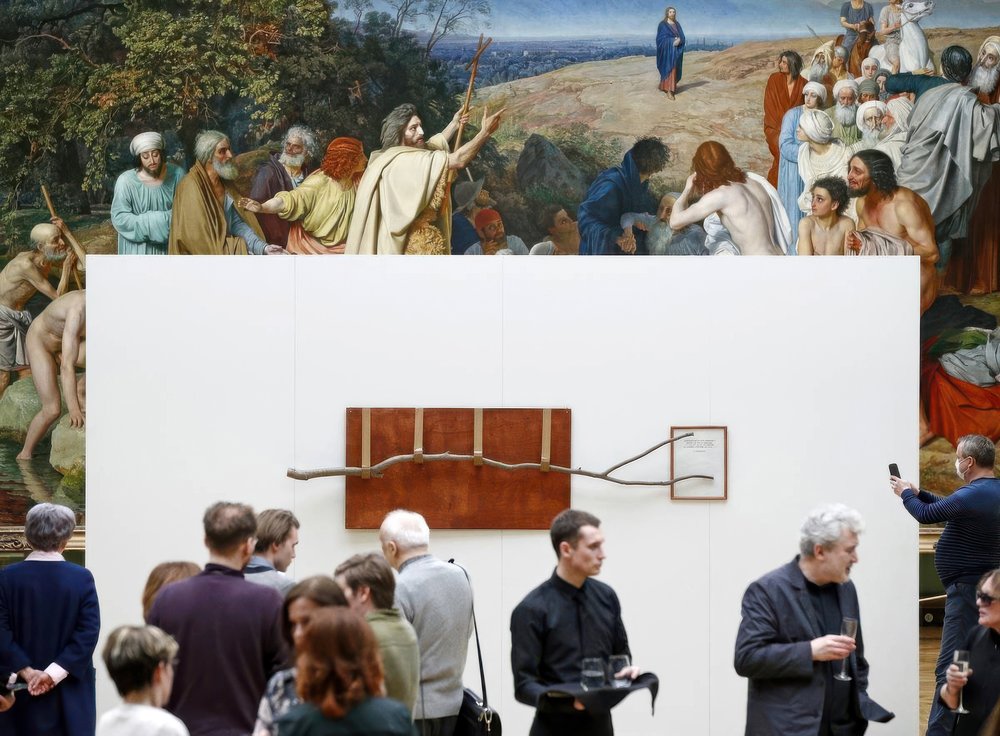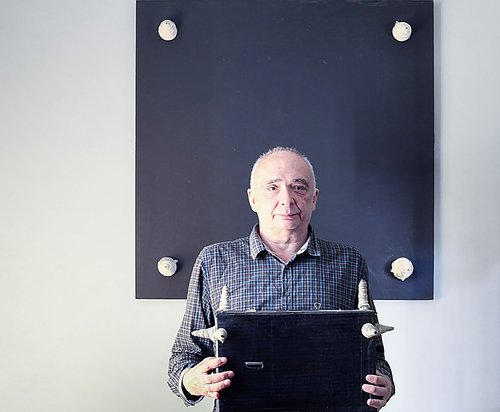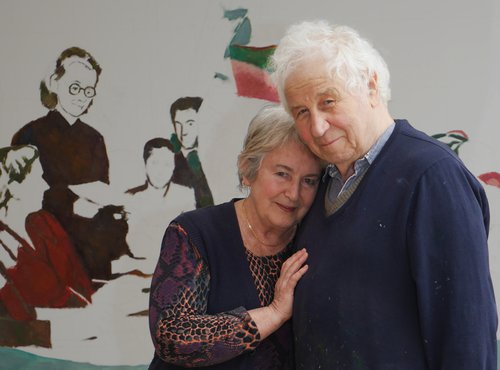Bewilderment as an Artistic Object

Andrei Monastyrski. The Branch, 1996. Exhibition view at the Tretyakov Gallery. Courtesy of TASS and Artem Geodakyan
Artistic bewilderment can provoke not just confusion, but a powerful emotional and intellectual response. Art critic Sergey Guskov explores how unexpected forms and unconventional expressions in Russian contemporary art have become meaningful gestures, challenging norms and redefining the viewer’s experience and expectations.
Artists can often surprise viewers, and sometimes even their fellow artists, with the unexpected because they useexcessively bold and avant-garde approaches which are ahead of their time, or their work balances on the edge of kitsch and poor taste. However, there are rare situations when art works are created in such a way that they cause genuine perplexity both among members of the public and art professionals, and these works can actually prove to be powerful gestures, despite their shocking or puzzling appearance.
Such artists in the late 1970s and early 1980s were the ‘Mukhomory’ group consisting of Sven Gundlach (1959-2020), Konstantin Zvezdochetov (b. 1958), Alexei Kamensky (b. 1956) and Vladimir and Sergei Mironenko (both b. 1959). Later, at the end of the 1980s, they were succeeded by the ‘Champions of the World’ group - Gia Abramishvili (b. 1966), Igor Zaidel (b. 1965), Konstantin Latyshev (b. 1966), Boris Matrosov (b. 1965), Gor Chahal (b. 1961), Andrei Yakhnin (b. 1966), and others. Their activities at the intersection of different art practices was confusing for observers whetherviewers, colleagues, art critics, or the state authorities.
The main perpetrator of perplexity, however, was Andrei Monastyrski (b. 1949), active around the same time as the Mukhomory, although slightly older. As well as organising actions, performances and happenings - in particular, the famous ‘trips to the countryside’ - the artist is known for having produced numerous art objects. One of them, ‘The Branch’, created in the Autumn of 1996, continues to provoke heated debate. Originally shown at the XL Gallery in Moscow, this work resembles the kind of information board you might find in an institution, except that instead of instructions, or comments with important information or details of fire-fighting equipment, there are four rolls of sticky tape and a branch is threaded through them. Next to this construction is a sheet with a self-quotation: "A. Monastyrsky... Whatever excerpt from Stockhausen's articles about Webern I would use here, it would still be, as they say, 'not that music', 'not quite it', etc...".
Created at the decline of Moscow conceptualism, when the art scene was occupied by very different personalities, and the heroes of unofficial art and the Soviet underground themselves began to slowly but steadily bronze into monuments, ‘The Branch’ essentially became a clear line separating the living process of conceptualist art in Russia from subsequent self-repetitions and monuments to themselves. At the same time, the work preserved the spirit of underground art, encrypted to the extreme, hermetic, yet made, as they say, "from shit and sticks" and mysteriously winking at the viewer. Furthermore, this work by Monastyrsky anticipated the object art of the second half of the 2010s, which put an end to post-conceptual aesthetics.
‘The Branch’ gained fame in narrow artistic circles back in the 1990s, but real turbulence in the life of this work of art began in early 2020, when the State Tretyakov Gallery acquired it for the permanent collection. Prior to that it had been exhibited a few times: at Monastyrsky's retrospective in the Moscow Museum of Modern Art (2010-2011) and as part of an important curatorial project by Elena Selina about the 1990s, ‘Reconstruction’, at the Ekaterina Cultural Foundation in Moscow (2014). However, in both places, the audience turned out to be insufficiently broad, and also the Branch was either only exhibited alongside other works by Monastyrsky or similar artists. At the State Tretyakov Gallery, however, all the stars aligned. This museum is firmly associated with traditional, classical art, primarily of the 19th century, but also of the 20th century.
Thus, unofficial and post-Soviet art, which began to seep into the Tretyakov Gallery in an increasingly turbulent flow from the late 1990s onwards, was constantly under attack from conservative forces. And when the Tretyakov Gallery announced that it had acquired ‘The Branch’ as one of the key works of the 1990s, an altercation began on the internet even though the purchase was made not with state funds, but with money from the museum's endowment fund, essentially donations from private benefactors. Critics still insisted it was a waste of public money. Moreover, during the presentation of the new acquisition, the work was hung in the same room as ‘The Appearance of Christ to the People’ (1837-1857) by Alexander Ivanov (1806-1858). A photograph of this juxtaposition spread across social and mass media; it was even shown on media facades and video screens of news agencies in Moscow, as well as on television. Anonymous Telegram channels specialising in denunciations and black PR, regarded the appearance of ‘The Branch’ in the Tretyakov Gallery as possibly the main transgression of its then-director, Zelfira Tregulova. They constantly cited Monastyrsky's work as an example of incorrect cultural policy and a subversion against traditional values, expressed, naturally, by the classics. Currently, ‘The Branch’ has been removed from the permanent exhibition, but it continues to stir in people’s minds.
Viktor Skersis (b. 1956) is better known as a fleeting member of various artistic associations: Gnezdo (Nest) (together with Gennady Donskoy (b. 1956) and Mikhail Roshal (1956-2007), 1970s), SZ (together with Vadim Zakharov (b. 1959), 1980s), Cupid (together with Yuri Albert (b. 1959), Paruyr Davtyan (b. 1976), Andrei Filippov (1959-2022), 2010s) and others. But he also has a body of independent work. In March 2025, at the opening of the exhibition ‘Power Source’, which showcased works from the Stella Art Foundation collection, the main star of the evening was Skersis's painting entitled ‘Abstract Composition No. 6 (Pig at the Piano)’ (2021). All guests initially reacted to it with an awkward smile, then they seemed to experience an epiphany, and after a few minutes, they tried to take pictures in front of the canvas.
On it, on the right side, there is indeed a pig playing the piano. It wears a dress, has a cigarette in its mouth, and there's a glass of prosecco on the piano. A second pig, also in a dress, dances merrily in the centre of the painting. And finally, on the left side of the canvas, a wolf in a striped sailor's shirt is dancing, so carried away that his sailor's cap is flying off. The background appears to be a cloudy sky. The work is painted in a deliberately primitivist style, maximally artless. Generally, the entire series, which includes this work, according to a story put out by the artist, is considered abstract: Skersis jokes that he was painting non-figurative compositions, and if the paints formed in such a way that the viewer sees some specific images, it is a coincidence. Be that as it may, even if this story is omitted, the insolence with which the artist created this work is striking at first glance. And the viewer's epiphany after the ensuing perplexity is that the work teaches one not to be afraid to pursue the most daring paths in art.
In 2021, a large exhibition of students from Moscow art schools opened at Winzavod Centre for Contemporary Art located at a former winery. Among others, a display in the basement by students from Joseph Backstein's Institute of Contemporary Art, entitled ‘Time of Things’. One of the works there was long remembered by those who saw it - a gigantic white chess knight, almost double the height of a human being. The sculpture is called ‘50:1’, and the artist's name is Alexander Sokolov (b. 1986). He is indeed passionate about chess and has created many works with chess pieces. But never anything on the scale of that monumental knight. People who came to that exhibition were, to put it mildly, blown away. Cultural journalist Julietta Sarkisian posted an image of Sokolov's object on Instagram with the caption "help!" This negative reaction was shared by many visitors to the exhibition. But among artists, opinions were more ambiguous.
They said that in this work, there is certainly a kind of wilful straightforwardness, but thanks to its scale, it is even interesting. Someone recalled the classic line "it's so bad that it's good". Around the same time, members of anindependent artist-run studio-gallery I.P. Vinogradov were looking for someone to display in their space and they even thought of offering Sokolov to exhibit his giant knight work there. However, in a rather odd way because the exhibition space at I.P. Vinogradov was a narrow room where the chess piece could only be exhibited lying down on its side practically butting against the walls.
Viewers would have had to squeeze along the sides to appreciate the power of the work. Unfortunately, this exhibition remained unrealised, as the gallery founders could not find a way of transporting the chess piece to the gallery. It would have required removing the window frame, hiring a crane, and coordinating all this bedlam with the security and management of the factory where the I.P. Vinogradov gallery was located. But even as a dream, this exhibition seems beautiful and majestic. Although the artist himself, it seems, does not even know about it.













